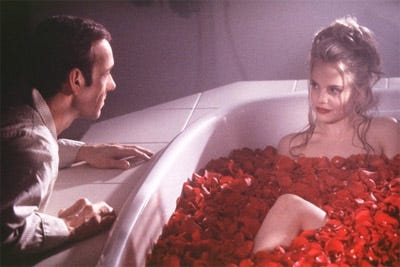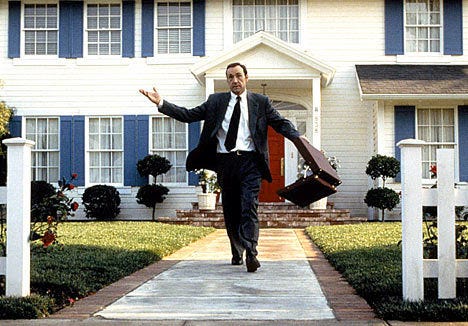American Beauty (1999)

“It’s called the American Dream because you have to be asleep to believe it” — George Carlin 1999’s “American Beauty” follows a man as he wakes up from this dream and fights to make it a reality. A suburbanite in the midst of a midlife crisis, his quest is one to which any moviegoer can relate — the search for magic within the mundane. Numbed by normalcy, Lester Burnham (Kevin Spacey, in a definitive performance) aims to break free of monotony, quitting his job and working out in an attempt to impress his teenage daughter’s sexy friend. He embodies the inverse archetype of the American Dream in the sense that his vision of success is one without professional or domestic responsibility. But it’s ultimately the same dogged pursuit of happiness. The film follows several other suburbanites searching for different incarnations of the same ideal: Lester’s wife, Carolyn (Annette Bening), strives for success in a male-dominated profession; Jane (Thora Birch), his daughter, saves money for a breast augmentation while rebelling against the standards of beauty to which her blonde friend and aspiring model Angela (Mena Suvari) is absurdly conformist. Like him, Lester’s neighbor Ricky (Wes Bentley) aims for a carefree existence, engaging curiosity at every turn; and finally, Ricky’s parents are like twisted parodies of the “American Dream family” — his father an uptight military man, his mother mute from years of subservience. British stage director Sam Mendes leaves an indelible impression with this silver screen debut, imbuing the intimate drama with a distinct and dazzling visual style (with, of course, a little help from master cinematographer Conrad Hall).
The film captures American desires more vividly than all but a handful of films over the last 20 years; few suburban dramas are as thrillingly cinematic. Florid (with red rose petals as a recurring motif) and highlighted by a background of white and blue, the film arrestingly embodies the American Dream; you can’t take your eyes off it.

The idyllic setting is merely a veil; its function as a façade is made obvious by the soft, dreamy lighting. It's an amplification of the everyday in which everything is saturated and surreal. The film ultimately subverts this Rockwellian vision of America, unearthing the morally murky desires buried beneath its residents’ white picket fences. As in 1998’s “Happiness,” the film juxtaposes the lead character’s immoral sexual urge with his domestic life’s chipper Mayberry aesthetic. Both films play up the dark humor in this collision between the wicked and the “normal.” With his perpetually sarcastic voice and devilish demeanor, Spacey brings the screenplay’s sardonic wit to vivid life. Sensitively portrayed by Bentley, Ricky seems to serve as an embodiment of Lester’s youth as well as the film’s sense of enchantment, carrying a camera with him at all times in the hopes of capturing beauty. His eyes are the rose-colored glasses through which the other characters want to see. While most critics praise its aesthetic and performances, many argue that the film falls short in its reach for profundity, that it’s ultimately skin-deep. But that seems like an unfair criticism of a film about the surface of reality. ("This is my life," Lester says offscreen amidst a shot of his bright, tree-lined street.) While “American Beauty” does join its characters in the search for life’s meaning, it seems primarily focused on engaging the senses, crystallizing the somewhat nebulous concept of American values. (Isn’t that film’s primary mission — not to deliver explicit messages but simply give concrete form to abstract ideas?) Perhaps the film’s only real “conclusion” lies in its visual suggestion of “middle-class America as paradise, plastic prison, and reverie, all at the same time” (as Entertainment Weekly’s Owen Gleiberman wrote in his review). To me, the film’s substance lies in its style. Because of its ethereal aesthetic, this small suburban drama ultimately feels larger than life. In painting a portrait of America that is at once familiar and otherworldly, it succeeds where all films strive, bridging the gap between reality and its funhouse reflection.
[youtube http://www.youtube.com/watch?v=CJM5u7jevDQ&w=530&h=315]
